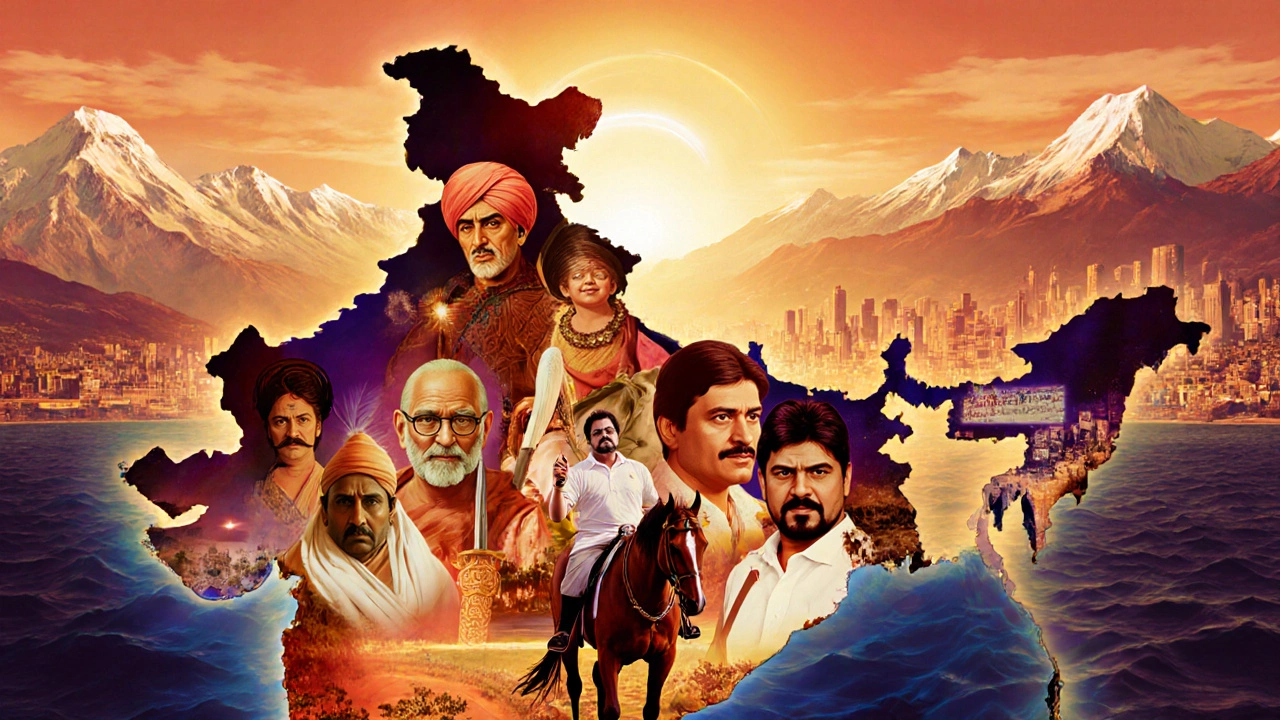Who Is India's Legend? Top Historical and Cultural Icons Explained

India's Legends Explorer
Discover key Indian legends and their contributions to society, politics, arts, and sports.
Legend Details
When you hear the phrase legend of India is a title given to those whose lives have shaped the nation’s identity, values, and global image, you probably picture a mix of warriors, writers, freedom fighters, and pop culture giants. India’s 7‑billion‑strong tapestry has produced figures that still inspire debates over who truly deserves the label. Below we unpack the most celebrated personalities, why they matter, and how they compare across eras and fields.
Key Takeaways
- Legends span politics, arts, sports, and mythology, each reflecting a unique facet of Indian heritage.
- Mahatma Gandhi’s non‑violent leadership remains the benchmark for civil rights movements worldwide.
- Shivaji Maharaj exemplifies strategic warfare and governance that still influences modern leadership studies.
- Rani Lakshmibai’s bravery illustrates the role of women in India’s fight for independence.
- Contemporary icons like MSDhoni and Amitabh Bachchan show how legends can emerge from entertainment and sports, shaping global perceptions of India.
Why India Produces Legends
India’s diversity fuels its legends. From the Himalayan foothills to the coastal plains, linguistic and cultural variations create a fertile ground for exceptional stories. Religion, colonial history, and rapid modernization intertwine, giving everyday people a stage to become larger‑than‑life characters. Moreover, the country's oral tradition-epics like the Mahabharata and Ramayana-sets a precedent for hero worship, making it natural for modern figures to be elevated to legendary status.
Mahatma Gandhi - The Father of the Nation
Mahatma Gandhi was a political activist who pioneered non‑violent civil disobedience. Born in 1869, Gandhi led the Indian independence movement against British rule using peaceful protests such as the Salt March (1930). His philosophy, termedSatyagraha, inspired civil‑rights leaders worldwide, including MartinLutherKingJr. and NelsonMandela. Gandhi’s legacy endures in India’s Constitution, which enshrines principles of justice, equality, and peaceful protest.
Shivaji Maharaj - Warrior King
Shivaji Maharaj founded the Maratha Empire in the 17thcentury, establishing a strong naval force and an administrative system that rivaled the Mughal Empire. Known for his guerrilla tactics, Shivaji protected the western coast from foreign invasions and promoted Marathi language and culture. His coronation in 1674 marked the birth of a sovereign Hindu state, and his governance model still informs modern Indian political science curricula.
Rani Lakshmibai - The Brave Queen
Rani Lakshmibai of Jhansi became a symbol of resistance during the 1857 Rebellion. After her husband’s death, she assumed control of the kingdom and led troops against the British East India Company. Her daring cavalry charge in June1858 remains a popular story in school textbooks and Bollywood films, highlighting women’s leadership in India’s fight for self‑rule.
Rabindranath Tagore - Literary Giant
Rabindranath Tagore earned the Nobel Prize in Literature in 1913, the first Asian to do so. His anthology “Gitanjali” introduced the West to Indian spirituality and humanism. Tagore also composed the Indian national anthem “Jana GanaMana” and founded Visva‑Bharati University, promoting education that blended Eastern and Western thought.
Satyajit Ray - Cinema Maestro
Satyajit Ray revolutionized Indian cinema with the “Apu Trilogy” (1955‑1959), earning global acclaim for its humanistic storytelling and subtle visual style. Ray’s work earned him an Academy Award for Lifetime Achievement (1992) and paved the way for modern Indian filmmakers to compete on the world stage.
MSDhoni - Cricket Icon
MS Dhoni captained the Indian cricket team from 2007 to 2016, leading India to win the 2007 ICCWorldTwenty20, 2010 and 2016 Asia Cups, and the 2011 ICCCricket World Cup. Known for his calm demeanor and unconventional strategies, Dhoni popularized the “finish‑the‑match” role of a wicket‑keeper‑batsman, influencing a generation of cricketers worldwide.
Amitabh Bachchan - Bollywood Legend
Amitabh Bachchan rose from a struggling actor to the “Shahenshah of Bollywood” in the 1970s. With a career spanning over five decades and more than 200 films, his deep voice and commanding screen presence have made him a cultural ambassador for India. Bachchan’s philanthropic work and presence on social media keep his legend alive for younger audiences.
Comparison of India’s Most Celebrated Legends
| Name | Era | Primary Field | Iconic Contribution |
|---|---|---|---|
| Mahatma Gandhi | 1869‑1948 | Politics / Social Reform | Non‑violent independence movement |
| Shivaji Maharaj | 1630‑1680 | Military / Governance | Founding the Maratha Empire |
| Rani Lakshmibai | 1828‑1858 | Military / Leadership | Heroic role in 1857 Rebellion |
| Rabindranath Tagore | 1861‑1941 | Literature / Education | Nobel Prize in Literature (1913) |
| Satyajit Ray | 1921‑1992 | Film / Arts | Apu Trilogy - global cinema classic |
| MS Dhoni | Born 1981 | Sports (Cricket) | 2011 World Cup‑winning captain |
| Amitabh Bachchan | Born 1942 | Film / Entertainment | Iconic Bollywood star for 50+ years |
Frequently Asked Questions
Who is universally called the legend of India?
Mahatma Gandhi is most often referred to as India’s legend because his philosophy of non‑violence shaped the nation’s independence and continues to influence global movements.
Can a sports star be a legend of India?
Yes. Figures like MSDhoni have become legends by leading India to major cricket victories, turning the sport into a unifying national passion.
Are women considered legends in Indian history?
Absolutely. Rani Lakshmibai, Mother Teresa, and Kalpana Chawla are celebrated for their courage, compassion, and pioneering achievements.
How do modern Indian legends differ from historical ones?
Historical legends often emerged from wars or independence struggles, while modern legends usually gain fame through media, entertainment, or sports, reaching a global audience instantly.
What criteria make someone a legend of India?
Impact on society, lasting influence, widespread recognition, and a narrative that embodies Indian values such as resilience, creativity, and service.